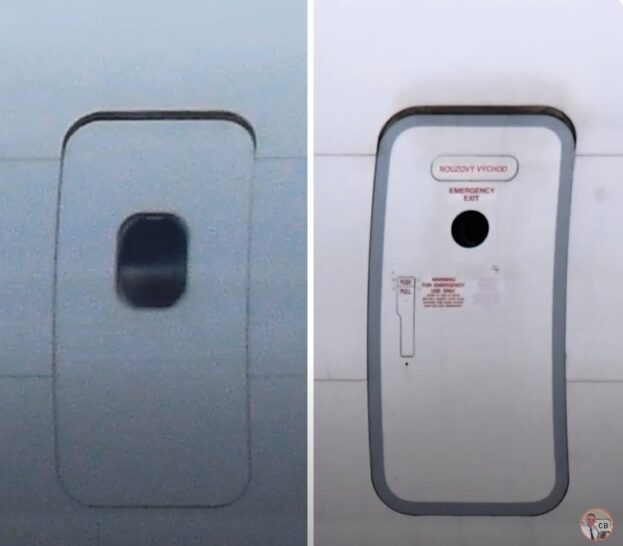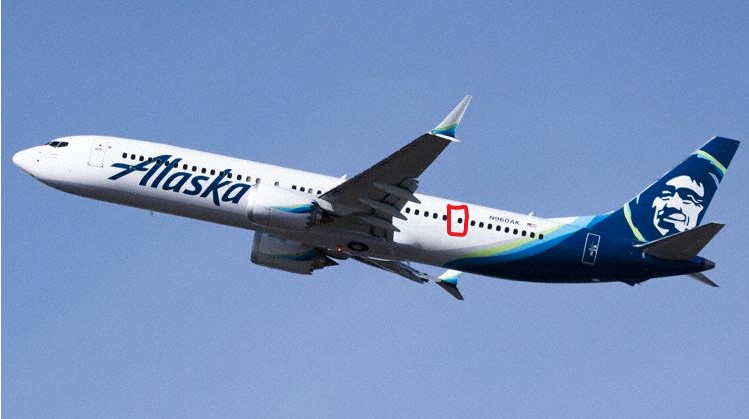It’s been 13 days since the plug door blew off of Alaska Airlines flight 1282. Since that day, the FAA has gone back and forth on how and when the Boeing 737 MAX9 would return to service. Since then, there have been finger-pointing and the blame game is in full swing. First today, the latest status from the FAA.
If you missed the previous posts on the 737 MAX9 door blowout, you can find them here:
- Part 1, What is a Boeing 737 MAX9 Door Plug That Failed? Why Is It There?
- Part 2, The “Nuts & Bolts” Of The Missing 737 MAX9 Plug Door
- Part 3, The 737 MAX9 Door Saga Continues. The FAA Wants Answers
- Part 4, Alaska Airlines CEO: Next Steps On The Boeing 737 MAX9
Updates on Grounding of Boeing 737 MAX 9 Aircraft
This information is preliminary and subject to change.
After taking decisive action to ground 171 Boeing 737-9 MAX airplanes, the FAA is now investigating Boeing’s manufacturing practices and production lines, including those involving subcontractor Spirit AeroSystems, bolstering its oversight of Boeing, and examining potential system change.
On Friday, the FAA announced requirements for a rigorous inspection and maintenance process as a new and necessary step before the FAA contemplates any further steps in the process to return Boeing 737-9 MAXs to service. The first 40 inspections that are part of that process are now complete, and the FAA will thoroughly review the data from them. All 737-9 MAX aircraft with door plugs will remain grounded pending the FAA’s review and final approval of an inspection and maintenance process that satisfies all FAA safety requirements. Once the FAA approves an inspection and maintenance process, it will be required on every grounded 737-9 MAX prior to future operation. The safety of the flying public, not speed, will determine the timeline for returning these aircraft to service.
The Failed Plug Door
If you have missed the 737 MAX9 grounding issues here is what it looks like:

The plug door is not a new feature of the 737. The 737-900 ER has been flying for years with the same plug door without incident.

I will let Chris Brady of theBoeing 737 technical site describe the issue, the investigation and what the resolution will look like.
FAA to Audit The Boeing 737 Line
When it comes to building aircraft, parts are made in a precise manufacturing environment from engineering specifications and drawings. Aircraft are built using these precision manufactured parts assembled by experienced technicians following precise assembly documentation in an environment of quality control. Inspectors on the line are required to inspect assemblies and sign off on these assemblies before they head to the next station.
Quality compliance and industrial safety are cultures that are supposed to exist in aircraft manufacturing. The plug door is designed to remain securely in place as long as the four bolts that lock the plug in place have been correctly installed. As I stated previously, the FAA does not have the number of inspectors to police the manufacturers. The Federal Government does not have the budget to pay inspectors the kind of money that airlines can afford to pay. The FAA can and should hire contract inspectors and bill the cost back to Boeing. Just Boeing? The same quality audit should take place at Spirit Aerosystems in Witchita KS where the 737 fuselage parts are made including the plug doors. Spirit also builds the fuselage assembly and then ships them by rail to the Boeing 737 product line in Renton, WA. Spirit has a history of quality issues so they should face the same audit.
The FAA audit will increase oversight of Boeing’s production and manufacturing. The FAA said Friday that it would audit Boeing’s 737 Max 9 production line and its suppliers “to evaluate Boeing’s compliance with its approved quality procedures.” The results of the initial audit will determine whether additional audits are needed, the agency said.
“After taking decisive action to ground 171 Boeing 737-9 MAX airplanes, the FAA is now investigating Boeing’s manufacturing practices and production lines, including those involving subcontractor Spirit AeroSystems, bolstering its oversight of Boeing, and examining potential system change,” the FAA said.
Boeing held a Companywide quality stand down directed by David Calhoun with the Commercial Airplane President and CEO Stan Deal.
In a message to employees, Stan Deal announced immediate actions the company is taking to bolster quality assurance and controls in 737 production.
“As we continue to respond to the Alaska Airlines Flight 1282 accident, our team has been working with the five affected airlines to inspect their 737-9 fleet. They have been examining and collecting measurements around the mid-exit door plugs to ensure they are installed per specifications.
While we complete these tasks to earn Federal Aviation Administration approval to unground the affected 737-9s, our team is also taking a hard look at our quality practices in our factories and across our production system.
We have taken important steps in recent years to strengthen our Quality Management System’s (QMS) foundation and its layers of protection. But, the AS1282 accident and recent customer findings make clear that we are not where we need to be. To that end, we are taking immediate actions to bolster quality assurance and controls across our factories.
- More quality inspections: We are planning additional inspections throughout the build process at Boeing and at Spirit. These checks will provide one more layer of scrutiny on top of the thousands of inspections performed today across each 737 airplane, and build on the reviews we have implemented to catch potential non-conformances. Since 2019, we have increased the number of Commercial Airplanes quality inspectors by 20% and we plan to make more investments in the Quality function.
- Team sessions on quality: We are planning additional sessions for our teams to gather and refocus on the fundamentals of our QMS, take advantage of our expanded training programs, and recommit to improving quality and compliance.
- Boeing review of Spirit work: We have deployed a team to work alongside Spirit AeroSystems to complement the existing teammates on the ground. Our team is now inspecting Spirit’s installation of the mid-exit door plug and approving them before the fuselage section can be shipped to Boeing. We are also inspecting more than 50 other points in Spirit’s build process and assessing their build plans against engineering specifications.
- Airline oversight inspections: We are opening our factories to 737 operators for additional oversight inspections to review our production and quality procedures. Spirit will do the same and we will learn from our customers’ insights and findings.
- Independent assessment: An outside party will be brought in to thoroughly review the Quality Management System at Commercial Airplanes and suggest further improvements.
And as we prepare new 737-9s for delivery, we will conduct the same thorough inspections of the mid-exit door plugs as mandated by the FAA. Customer representatives will continue to have access to anything they want to see onboard their airplane before delivery.
These actions are separate from the FAA’s investigation and the agency’s plan to increase oversight of 737-9 production. We will cooperate fully and transparently with both as we work to restore trust with our regulator and our customers. And as the National Transportation Safety Board’s investigation proceeds, we will take additional steps to improve our practices as the facts and findings dictate.
Everything we do must conform to the requirements in our QMS. Anything less is unacceptable. It is through this standard that we must operate to provide our customers and their passengers complete confidence in Boeing airplanes. Let each one of us take personal accountability and recommit ourselves to this important work.”
In addition to the presence of the FAA audit team, Boeing is allowing their 737 MAX customers come to the assembly line and do their own inspections of the manufacturing process.
Boeing has had a history of quality control issues in recent years:
- The 787 line in Charleston SC had to stop deliveries of new aircraft due to improper fuselage sections assembly,
- The KC-46 Air Force tanker aircraft have been delivered with construction trash and even a ladder on new aircraft deliveries.
Boeing is still behind in getting these aircraft certified airworthy by the FAA:
- 737 MAX7,
- 737 MAX10,
- 777-8 and
- 777-9.
All of these planes in the certification process are not new airplanes. The 777 variants and the remaining 737MAX variants are follow-ons to existing aircraft. The original 737-100 entered service with Lufthansa in 1967.
Spirit Aerosystems
Spirit Aerosystems in Witchita KS where the 737 fuselage parts are made including the plug doors. Spirit also builds the fuselage assembly and then ships them by rail to the Boeing 737 product line in Renton, WA. Spirit has a history of quality issues so they should face the same audit. This assembly line used to be owned by Boeing and operated by Boeing employees. Boeing spun this division off in 2005. With Boeing divesting itself of the fuselage division, the new entity could be assemblies for other manufacturers like Airbus.
“Spirit is supporting Boeing’s efforts with the FAA, and the affected airlines, as they inspect the 737-9 fleet and work to safely return those airplanes to service,” company spokesperson Joe Buccino said in a statement.
Yesterday, Boeing CEO Dave Calhoun visited Spirit AeroSystems in Wichita, Kansas, and held an employee town hall meeting with Spirit AeroSystems CEO Pat Shanahan and Spirit AeroSystems Board Chair Bob Johnson.
Dave shared the following with Spirit AeroSystems employees:
“We’re going to get better, not because the two of us are talking, but because the engineers at Boeing, the mechanics at Boeing, the inspectors at Boeing, the engineers at Spirit, the mechanics at Spirit, the inspectors at Spirit — they’re going to speak the same language on this in every way, shape or form. We’re going to learn from it, and then we’re going to apply it to literally everything else we do together.”
Congressional Investigation
Yesterday, the first closed-door hearings started. Since it is closed-door, there is no news about what happened in the hearing. After the closed close-door hearing concludes, there will be a public hearing.
Final Thoughts
The FAA has the data on the first 40 aircraft to make a determination on the corrective action that will be required to return the 737 MAX9 back to service. At the same time, the FAA will also be present on the 737 MAX assembly line to audit how the aircraft are made and if they are being constructed in accordance with the published manufacturing processes including the quality management system (QMS). After the FAA reviews the data, they will come up with an inspection directive for the airlines to complete the work and get the aircraft flying again. Hopefully, some of the aircraft can be cleared by late next week.
